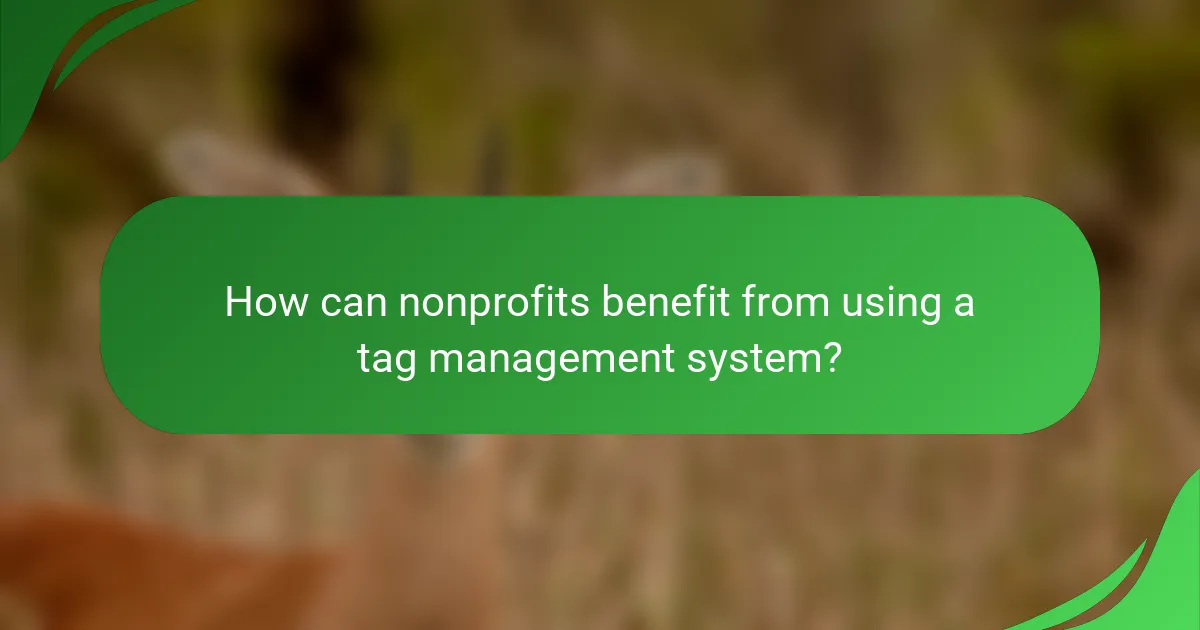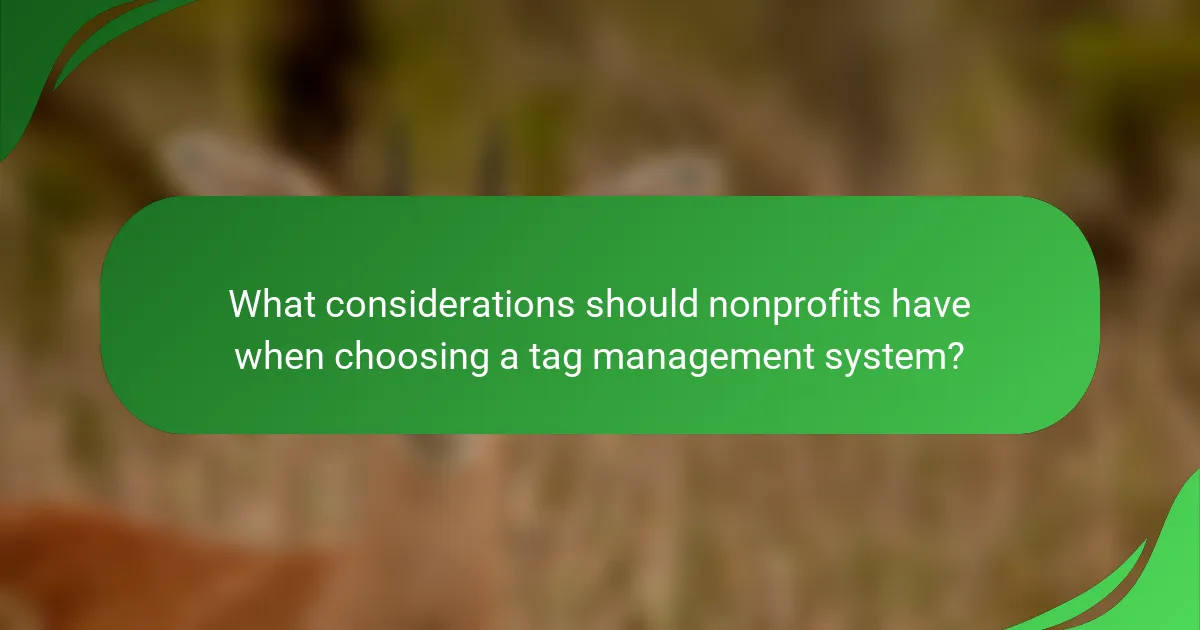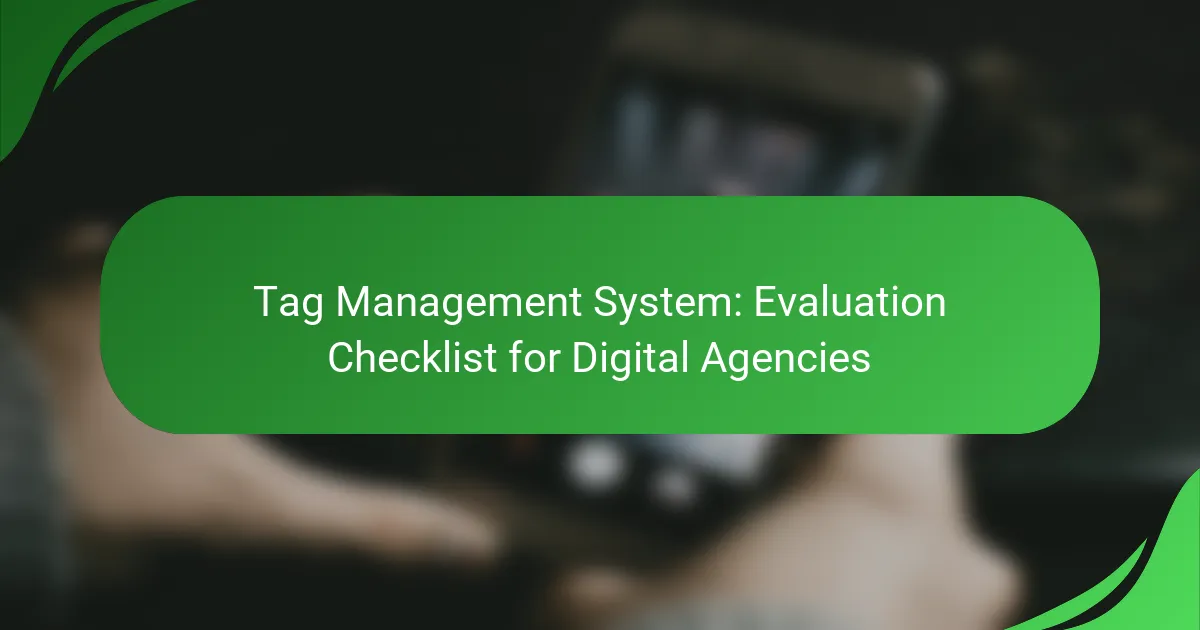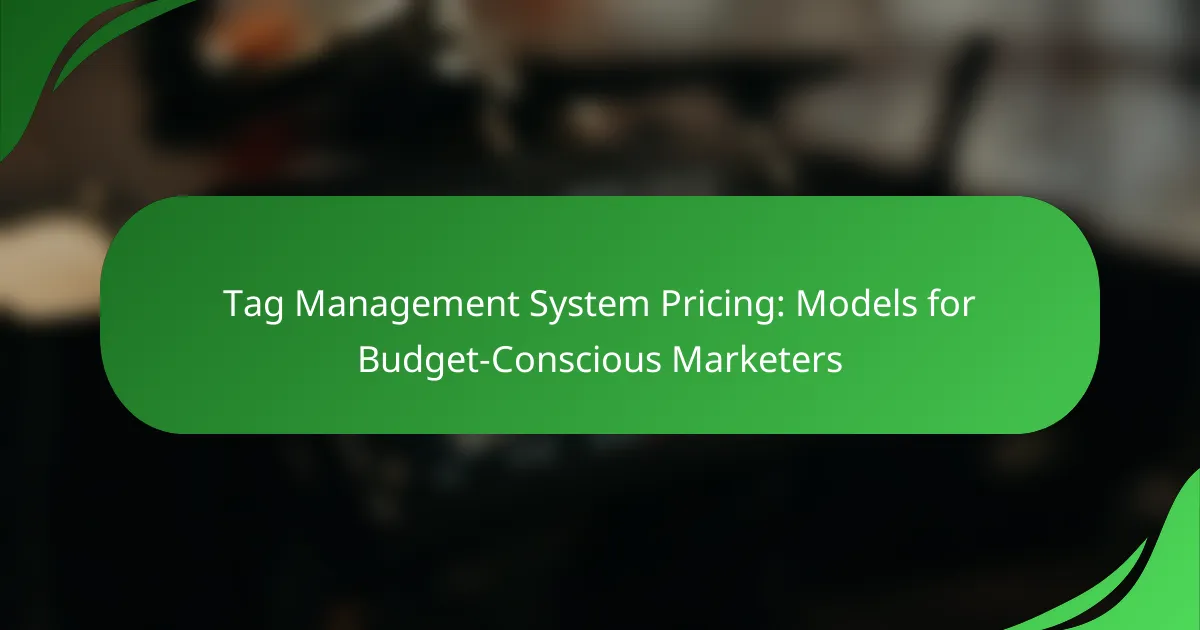For nonprofits looking to enhance their digital strategies, implementing a tag management system (TMS) can be a game changer. A TMS simplifies the management and deployment of tracking codes, enabling organizations to collect accurate data and optimize their online presence without the need for extensive coding skills. When selecting a TMS, nonprofits should consider budget, ease of use, integration capabilities, and available support to ensure it meets their unique operational needs.

What are the best tag management systems for nonprofits in Canada?
The best tag management systems for nonprofits in Canada include Google Tag Manager, Tealium, Segment, Ensighten, and TagCommander. These platforms help organizations efficiently manage and deploy marketing tags without extensive coding knowledge, making them ideal for nonprofits with limited resources.
Google Tag Manager
Google Tag Manager (GTM) is a free tool that allows nonprofits to manage website tags easily. It enables users to add and update tags from various marketing and analytics platforms without modifying the code directly.
GTM is particularly beneficial for organizations looking to streamline their tracking processes. With features like version control and built-in debugging tools, nonprofits can ensure their tags are functioning correctly before going live.
Tealium
Tealium offers a comprehensive tag management solution that includes data integration and customer data platform capabilities. Nonprofits can use Tealium to unify their data sources and enhance their marketing efforts.
While Tealium is a paid service, its robust features, such as real-time data collection and privacy compliance tools, can be advantageous for nonprofits looking to maximize their outreach while adhering to regulations like Canada’s Anti-Spam Legislation (CASL).
Segment
Segment is a customer data platform that simplifies the process of collecting and managing user data. Nonprofits can use Segment to track user interactions across multiple channels and consolidate this data for analysis.
With its user-friendly interface, Segment allows organizations to integrate various marketing tools seamlessly. This can help nonprofits create targeted campaigns based on user behavior, ultimately improving engagement and donations.
Ensighten
Ensighten is a tag management system focused on security and privacy compliance. It offers features that help nonprofits manage their tags while ensuring adherence to data protection regulations.
This platform is particularly useful for organizations that handle sensitive information, as it provides tools for consent management and data governance. Nonprofits should consider Ensighten if they prioritize user privacy in their digital strategies.
TagCommander
TagCommander is a European-based tag management system that offers a range of features tailored for nonprofits. It allows organizations to manage their tags efficiently while providing advanced analytics capabilities.
Nonprofits can benefit from TagCommander’s ability to support multiple languages and currencies, making it a suitable choice for organizations operating in diverse regions. Its user-friendly interface simplifies the process of tag deployment and management.

How can nonprofits benefit from using a tag management system?
Nonprofits can significantly enhance their digital strategies by implementing a tag management system (TMS). A TMS simplifies the process of managing and deploying tracking codes, allowing organizations to gather more accurate data and optimize their online presence.
Improved data accuracy
A tag management system helps nonprofits achieve improved data accuracy by centralizing the management of tracking codes. This reduces the likelihood of errors that can occur when manually adding or updating tags across multiple platforms.
With a TMS, organizations can ensure that the data collected from their websites and campaigns is consistent and reliable. This accurate data is crucial for making informed decisions regarding fundraising, outreach, and program effectiveness.
Enhanced tracking capabilities
Using a tag management system allows nonprofits to implement advanced tracking capabilities without needing extensive technical knowledge. Nonprofits can easily add and modify tags for analytics, conversion tracking, and remarketing.
This flexibility enables organizations to monitor user interactions more effectively, such as tracking donations, event registrations, or newsletter sign-ups. Enhanced tracking provides deeper insights into donor behavior and engagement, which can inform future strategies.
Cost-effective management
A tag management system can lead to cost-effective management by reducing reliance on IT resources. Nonprofits can manage tags independently, minimizing the need for ongoing technical support or development costs.
Additionally, many TMS solutions are available at various price points, including free or low-cost options suitable for smaller organizations. This affordability allows nonprofits to allocate more resources toward their core missions rather than technical overhead.
Streamlined marketing efforts
Implementing a tag management system streamlines marketing efforts by enabling quick adjustments to tracking setups. Nonprofits can rapidly deploy new marketing initiatives or campaigns without waiting for IT intervention.
This agility allows organizations to respond to trends and opportunities in real-time, enhancing their outreach effectiveness. By optimizing their marketing efforts, nonprofits can improve donor engagement and increase fundraising success.

What considerations should nonprofits have when choosing a tag management system?
Nonprofits should prioritize budget, ease of use, integration capabilities, and available support when selecting a tag management system. These factors ensure that the system aligns with their operational needs and financial constraints while enhancing their digital marketing efforts.
Budget constraints
Budget is a critical factor for nonprofits when choosing a tag management system. Many solutions offer tiered pricing, so it’s essential to evaluate options that fit within limited financial resources, often ranging from free to a few hundred dollars per month.
Consider the total cost of ownership, including potential hidden fees for additional features or support. Nonprofits should also explore discounts or grants from vendors that cater specifically to charitable organizations.
User-friendliness
User-friendliness is vital for nonprofits with limited technical expertise. A system with an intuitive interface allows staff to implement and manage tags without extensive training, saving time and resources.
Look for platforms that offer drag-and-drop functionality and clear documentation. A trial period can help assess whether the system meets the team’s needs and capabilities before committing financially.
Integration with existing tools
Integration with existing tools is crucial for maximizing the effectiveness of a tag management system. Nonprofits often use various platforms for email marketing, CRM, and analytics, so ensuring compatibility is essential.
Evaluate how well the tag management system integrates with tools like Google Analytics, social media platforms, and donor management software. Seamless integration can streamline data collection and enhance reporting capabilities.
Support and resources available
Access to support and resources can significantly impact the success of a tag management system. Nonprofits should consider the level of customer support offered, including availability of live chat, email, or phone assistance.
Additionally, look for educational resources such as tutorials, webinars, and community forums. These can help staff troubleshoot issues and optimize the use of the tag management system over time.

What are the key features of a tag management system?
A tag management system (TMS) simplifies the process of managing and deploying tags on a website. Key features include version control, customizable tags, and user-friendly interfaces that allow for efficient tracking and analytics.
Version control
Version control in a tag management system allows users to track changes made to tags over time. This feature is crucial for nonprofits that may need to revert to previous configurations if a new tag causes issues or does not perform as expected.
Implementing version control helps maintain a history of all changes, making it easier to audit and understand the impact of each tag. Nonprofits should regularly review version histories to ensure optimal performance and compliance with any relevant regulations.
Customizable tags
Customizable tags enable organizations to tailor tracking codes to their specific needs. Nonprofits can create tags that align with their unique goals, such as monitoring donations, event registrations, or volunteer sign-ups.
When using customizable tags, consider the types of data you want to collect and how it will be used. Ensure that tags are easy to implement and modify, allowing for quick adjustments as organizational needs evolve. Avoid overcomplicating tags, as this can lead to confusion and hinder data accuracy.



